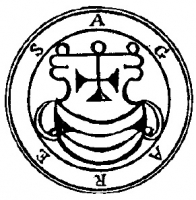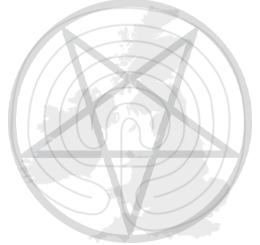Eliphas Levi
Alphonse Louis Constant (more commonly known by his pseudonym: Eliphas Levi), was an occultist and author who is considered to have greatly influenced the 19th century’s occult revival.
Levi was born on in Paris, France 8th February 1810 at a time when Napoleon was conquering continental Europe, and France was at war – following the bloodthirsty Revolution. Levi’s father was a shoe maker who couldn’t afford to pay for the education that his intelligent son deserved. Possibly through the Parish Priest, it was arranged for him attend the seminary of Saint Nichols du Chardonnet, and at a later date of Saint Sulpice to be educated as a Roman Catholic Priest.
 His interest in the occult was sparked during a lesson with his Headmaster where it was claimed that animal magnetism was a vital energy of the human body controlled by the Devil.
His interest in the occult was sparked during a lesson with his Headmaster where it was claimed that animal magnetism was a vital energy of the human body controlled by the Devil.
Levi met a couple called Ganneau in the early 1830’s who practiced a form of witchcraft. Ganneau believed himself to be a reincarnation of King Louis XVII, whilst his wife claimed to be that of Marie Antoinette. Becoming one of their followers Levi continued his studies of magic occultism.
Alphonse Louis Constant was ordained a Deacon in December 1835. He had written several works during his time in the church, these being Des Moeurs et des Doctrines du Rationalisme en France (Of the Moral Customs and Doctrines of Rationalism in France, 1839), L’Evangile du Peuple (The Gospel of the People, 1840), La Mere de Dieu (The Mother of God, 1844) and Le Testament de la Liberte (The Testament of Liberty, 1848). He was excommunicated from the church for his political views and for preaching doctrines contrary to the Church.
He met and married Noemi Cadiot in 1846. She was only 18 years of age and he was 36 years old. They separated in 1853 following the early death of their only child and the marriage was finally annulled in 1865. Constant had been making a living as a journalist and teaching occult studies under the name Magus Eliphas Levi (Alphonse Louis in Hebrew).
In May 1854, following his separation from his wife he visited England for the first time in the hope of making some money teaching the occult. Levi’s reputation as a French Magus had preceded him, and eased his passage into London’s high society. Amongst those who he met was Edward Bulwer-Lytton, 1st Baron Lytton of Knebworth (1803-1873) with whom he formed a lasting friendship. Bulwer-Lytton studied magic, astrology, clairvoyance and mesmerism. He was the president of a Rosicrucian group and regarded as an authority on the occult.
As Levi did not speak much English his teaching idea failed to make him any money. Whilst on this trip he was asked by a friend of Bulwer-Lytton to give a demonstration of Necromancy, something Levi had never tried before, a Lady of title requested that he conjure the spirit of Apollonius of Tyana who was a renowned ancient magician. His ritual preparation took three weeks during which he fasted and meditated on Apollonius. A Temple was specially prepared with four concave mirrors and an altar resting on lamb’s wool. The altar top was marble and a pentagram was carved upon it and a chain of magnetized iron was used as a magic circle of protection. On the altar were two small copper chafing-dishes with charred laurel and alder wood inside. Levi – who was alone -was dressed in a white robe with a wreath of vervain leaves entwined on a golden chain on his head. He held a sword and a copy of the ritual to be performed. Levi ran through twelve hours of incantations after which the floor reputedly shook and an apparition manifested before him. Levi was frightened, the figure before him was ‘wrapped from head to foot in a species of shroud, which seemed more gray than white; he was lean, melancholy and beardless’ The figured disappeared. He commanded its return with his sword. Something then touched his sword arm which went numb to the elbow and continued to ache for weeks afterwards. The figure re-appeared and at this point Levi became so weak that he fainted.
He was not convinced that this was Apollonius and rather that the effect that the ceremony preparation had on his mind was a kin to ‘an actual drunkenness of the imagination’. Accepting that the apparition could have been a hallucination, he believed that he had actually touched something very real. He states in his later work ‘I do not explain the physical laws by which I saw and touched something real; I affirm solely that I did see and that I did touch, that I saw clearly and distinctly, apart from dreaming, and this is sufficient to establish the real efficacy of magical ceremonies…..I commend the greatest caution to those who propose devoting themselves to similar experiences; their result is intense exhaustion, and frequently a shock sufficient to occasion illness’. He seemed to believe his experience was an effective demonstration of ritual magic ceremonies, but condemned its use as dangerous on health and moral grounds unless handled by an experienced adept. An account of this ritual is the work of another Golden Dawn member Arthur Edward Waite, from which the quote was taken. His Transcendental Magic, it’s Doctrine and Ritual is a translation of Levi’s magical treatise Dogme et Rituel de la Haute Magie which he wrote in 1855 after Bulwer-Lytton’s encouragement. The work features Levi’s famous image of Baphomet, a goat headed figure sitting cross legged:
 “The goat on the frontispiece carries the sign of the pentagram on the forehead, with one point at the top, a symbol of light, his two hands forming the sign of hermetism, the one pointing up to the white moon of Chesed, the other pointing down to the black one of Geburah. This sign expresses the perfect harmony of mercy with justice. His one arm is female, the other male like the ones of the androgyn of Khunrath, the attributes of which we had to unite with those of our goat because he is one and the same symbol. The flame of intelligence shining between his horns is the magic light of the universal balance, the image of the soul elevated above matter, as the flame, whilst being tied to matter, shines above it. The ugly beast’s head expresses the horror of the sinner, whose materially acting, solely responsible part has to bear the punishment exclusively; because the soul is insensitive according to its nature and can only suffer when it materializes. The rod standing instead of genitals symbolizes eternal life, the body covered with scales the water, the semi-circle above it the atmosphere, the feathers following above the volatile. Humanity is represented by the two breasts and the androgyn arms of this sphinx of the occult sciences.” – Levi on his Baphomet image.
“The goat on the frontispiece carries the sign of the pentagram on the forehead, with one point at the top, a symbol of light, his two hands forming the sign of hermetism, the one pointing up to the white moon of Chesed, the other pointing down to the black one of Geburah. This sign expresses the perfect harmony of mercy with justice. His one arm is female, the other male like the ones of the androgyn of Khunrath, the attributes of which we had to unite with those of our goat because he is one and the same symbol. The flame of intelligence shining between his horns is the magic light of the universal balance, the image of the soul elevated above matter, as the flame, whilst being tied to matter, shines above it. The ugly beast’s head expresses the horror of the sinner, whose materially acting, solely responsible part has to bear the punishment exclusively; because the soul is insensitive according to its nature and can only suffer when it materializes. The rod standing instead of genitals symbolizes eternal life, the body covered with scales the water, the semi-circle above it the atmosphere, the feathers following above the volatile. Humanity is represented by the two breasts and the androgyn arms of this sphinx of the occult sciences.” – Levi on his Baphomet image.
It was Lévi who separated the pentagram into good and evil applications, and incorporated his goat headed Baphomet into the inverted pentagram making it a new evil symbol.
His Dogme et Rituel de la Haute Magie begins with:
Behind the veil of all the hieratic and mystical allegories of ancient doctrines, behind the darkness and strange ordeals of all initiations, under the seal of all sacred writings, in the ruins of Nineveh or Thebes, on the crumbling stones of old temples and on the blackened visage of the Assyrian or Egyptian sphinx, in the monstrous or marvellous paintings which interpret to the faithful of India the inspired pages of the Vedas, in the cryptic emblems of our old books on alchemy, in the ceremonies practised at reception by all secret societies, there are found indications of a doctrine which is everywhere the same and everywhere carefully concealed”.
Levi believed in a universal secret doctrine of magic that prevailed throughout time. He also continued to believe in animal magetism, and expanded upon this with theories on Astral Light. It has been written that Levi saw King Solomons Temple as having the purpose of bringing peace to the world, and if you take the word Baphomet, reversed the letters to ‘Tem Ohp Ab’ you have a representation of the Latin Templi omminum pacis abbas or ‘The Father Of The Temple Of Peace Of All Men’. Baphomet is of course the name of the severed head that the Knights Templar were accused of worshipping and was instrumental in the charges against them.
Waite says in Transcendental Magic, its Doctrine and Ritual that, Levi revealed the secrets of an occult society that he had been initiated into and subsequently expelled from after publishing their secrets.
August 1854 saw Levi return penniless to Paris where his friend Adolphe Desbarolles, the author of a work on Palmistry called Les Mysteres de la Main helped with room and board. His trip to England had improved his reputation further, and upon his return to France he was able to attract students whom he taught the Kabbalah.
Levi returned to Knebworth to stay with Bulwer-Lytton in 1861, accompanied by his pupil Count Alexander Branicki. Kenneth Mackenzie, author of the Royal Masonic Encyclopedia and ranking member of the Societas Rosicruciana in Anglia met Levi on this trip and published an account of their meeting in which Levi confessed to have studied Tarot cards for over 26 years.
Levi died on 31st May 1875 (the same year Aleister Crowley was born and which no doubt helped convince Crowley that he was Levi reincarnated) having made a modest living on the profit of his writings and occult tuition.
1860 – History of Magic
1861 – La Clef des Grands Mysteres (The Key to the Great Mysteries)
1862 – Fables et Symboles (Stories and Images)
1865 – La Science des Esprits (The Science of Spirits)
1868 – La Grand ou l’Occultisme Devoile (The Great Secret or Occultism Unveiled) – published after his death in 1898.
Before his death he is supposed to have reconciled with the church and received last rites.
Levi is undoubtably a key historical occult figure who greatly influenced key members of the Golden Dawn such as Aleister Crowley, Arthur Edward Waite and the author of most of the orders rituals S L MacGregor Mathers.




Recent Comments